Key takeaways:
- Understanding spiritual texts involves personal reflection and connecting their teachings with individual experiences.
- Religious books serve as vital sources of wisdom and community, grounding individuals in their identities while providing solace during challenging times.
- Exploring contrasting spiritual texts can foster deep insights, prompting introspection and challenging rigid beliefs.
- Key lessons from spiritual journeys include the value of vulnerability, compassion, and the growth that arises from grappling with diverse perspectives.

Understanding spiritual texts
Understanding spiritual texts can often feel like embarking on a journey through uncharted territory. I remember my first encounter with a sacred text, feeling both excited and overwhelmed. How do we decode layers of meaning tucked beneath ancient words?
As I read, I became acutely aware of the emotions these texts stirred within me. There were moments of clarity where a simple phrase resonated deeply, urging me to reflect on my life. Have you ever found a particular line that seemed to speak directly to your experiences? It’s astonishing how spiritual texts can mirror our inner landscapes, inviting us to consider the profound implications of our own souls.
Moreover, engaging with these writings isn’t just about understanding the words on a page; it’s about letting them intertwine with our personal narratives. I often find myself contrasting my life lessons with what I read. By doing this, I uncover valuable insights that not only enrich my understanding but also nourish my spiritual growth. What lessons could you discover in these texts if you allowed them to impact your daily life?
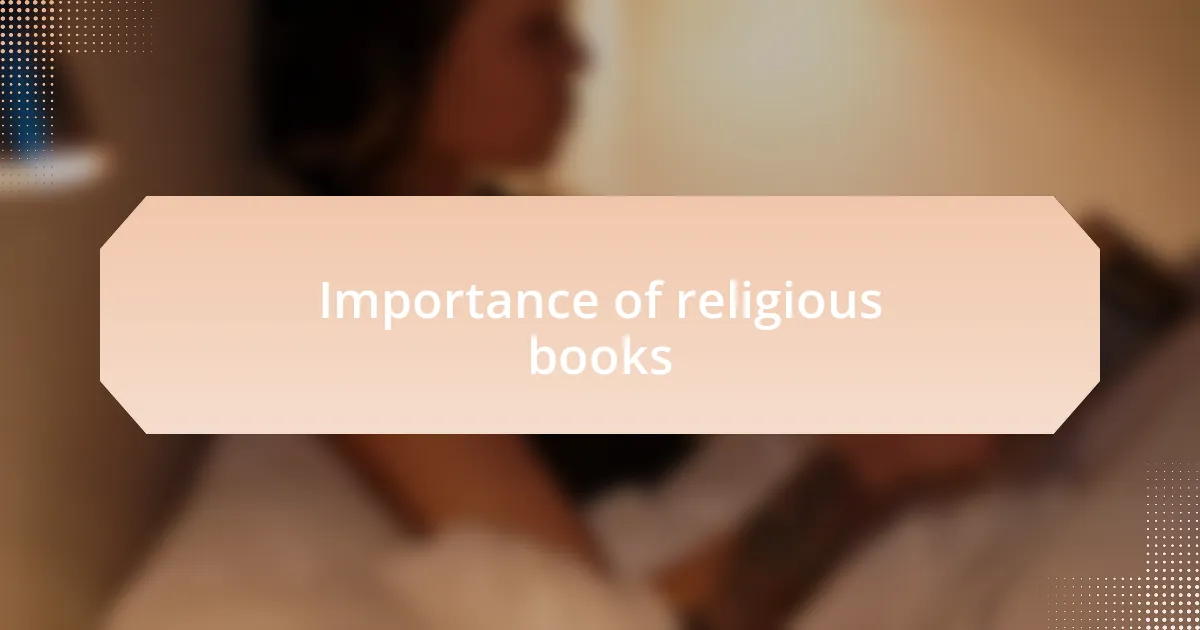
Importance of religious books
Religious books hold immense importance as they serve as a bridge between the divine and the everyday. I vividly recall thumbing through a beloved scripture during a difficult time; the verses seemed to leap off the page, providing solace and direction. It’s intriguing to consider how a single line can have the power to shift our mindset or soothe our aching hearts, isn’t it?
These texts are often repositories of wisdom, encapsulating the beliefs, struggles, and hopes of countless individuals across generations. I remember sitting with a friend during a discussion on a particular holy book. We found ourselves lost in the layers of meaning, realizing that these shared stories weren’t just relics of the past—they were reflections of our own challenges and aspirations. How can we underestimate the ability of these narratives to ground us in our identities?
Furthermore, engaging with religious literature fosters a sense of community and shared purpose. I’ve experienced this firsthand in group readings, where the insights draw diverse individuals together, creating vibrant dialogues. Isn’t it beautiful how such texts can inspire discussions that strengthen our bonds while illuminating our shared spiritual journeys?
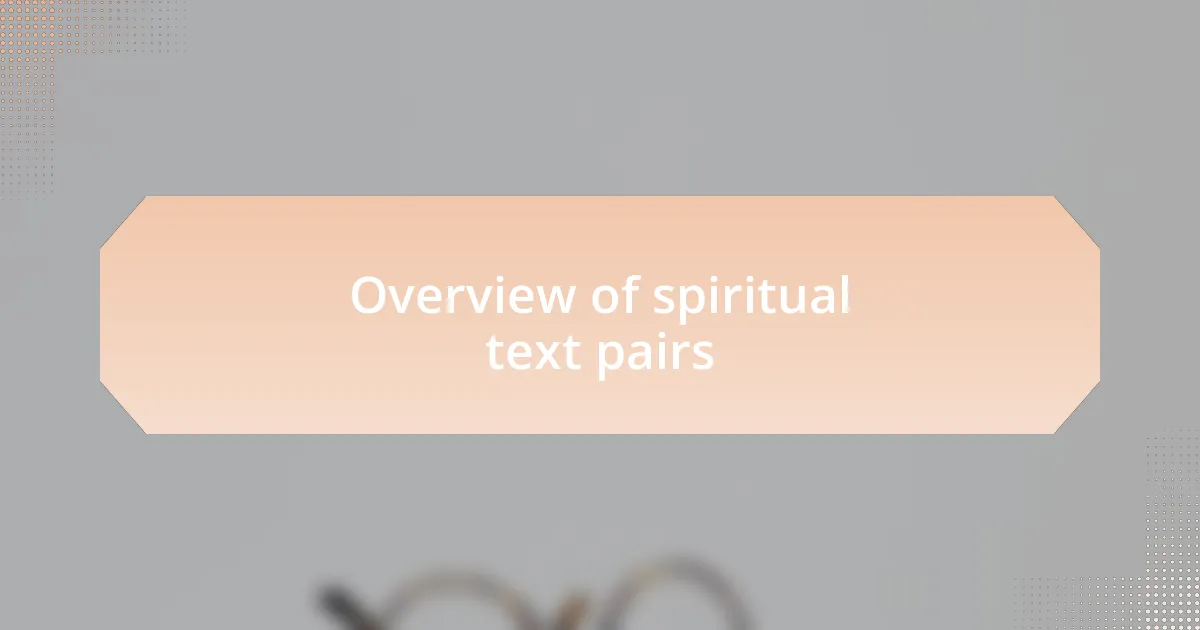
Overview of spiritual text pairs
Spiritual text pairs often present contrasting or complementary ideas that enhance our understanding of fundamental concepts. For instance, I remember pondering the fierce compassion of one text alongside the stark self-discipline of another. Such juxtaposition opened my eyes to the delicate balance we all strive for between strength and vulnerability, and it made me wonder—how can these opposing principles coexist in our lives?
One fascinating aspect I’ve noticed is how these pairs can lead to deeper insights when approached with an open heart. During a personal study session, I found myself exploring a text on forgiveness paired with one on justice. This dynamic duo prompted a rich inner dialogue, challenging me to reflect on my own beliefs about fairness versus mercy. It struck me that grappling with these texts can transform our understanding, making complex moral dilemmas more relatable and human.
Moreover, these text pairs can act as a compass, guiding us through life’s complexities. I often find myself revisiting a collection that includes both prophetic texts and those of personal reflection. Each time, I’m struck by how their interplay resonates with my own experiences, making me question how I relate to the world around me. Doesn’t it feel comforting to know that others have wrestled with similar dilemmas, offering wisdom that feels just within reach?
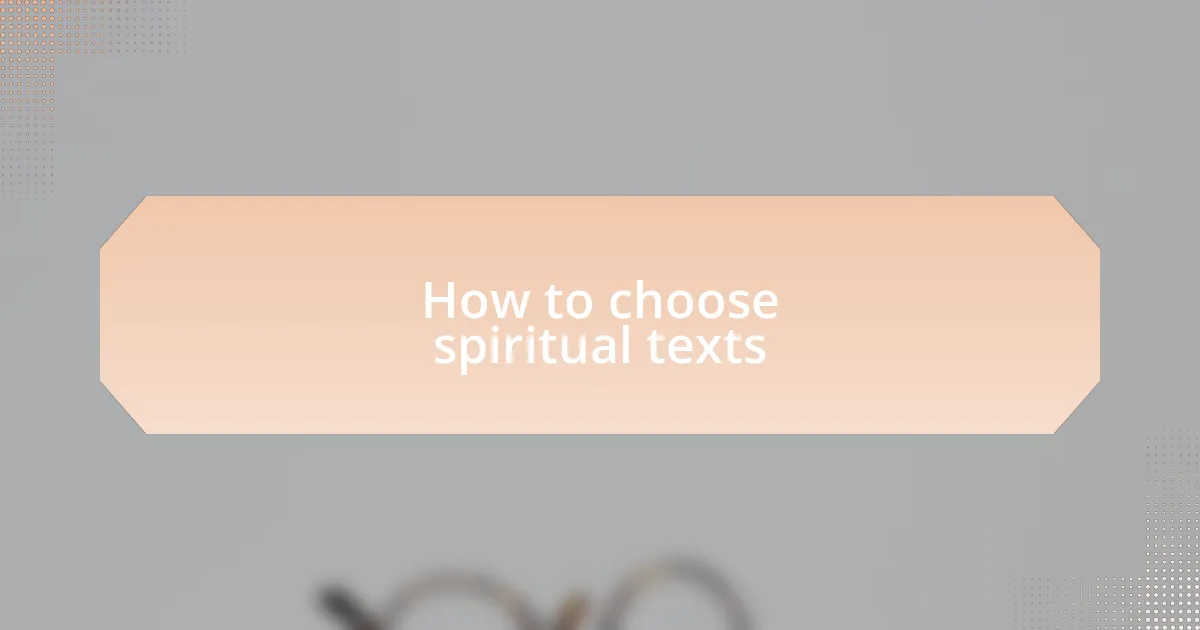
How to choose spiritual texts
Choosing spiritual texts can be a deeply personal journey, and I’ve found it helpful to consider what resonates most with my current state of mind. When selecting a text, I ask myself how it aligns with my personal struggles or aspirations. For example, I once reached for a book on mindfulness during a particularly chaotic period in my life, seeking solace and clarity amidst the noise. That choice turned out to be transformative, grounding me in practices that still influence my daily routine.
Another key factor in choosing spiritual texts is the context in which they were written. Understanding the historical and cultural background can illuminate the intentions behind the words. I recall reading a piece from ancient scripture that was rich in metaphor and required me to consider its relevance in today’s world. That experience taught me that insights often stretch beyond their original context; they can be reinterpreted to address our modern dilemmas.
Lastly, I encourage you to pay attention to how a spiritual text makes you feel. Do its words ignite a spark of curiosity, or do they evoke a sense of comfort? I remember opening a book and being struck by a single passage that resonated with my innermost doubts. It made me realize that the right text might not always provide easy answers but instead encourages deeper reflection and growth. How can we embrace texts that challenge us while also nurturing our spirits? Embracing that paradox is a big part of the journey.
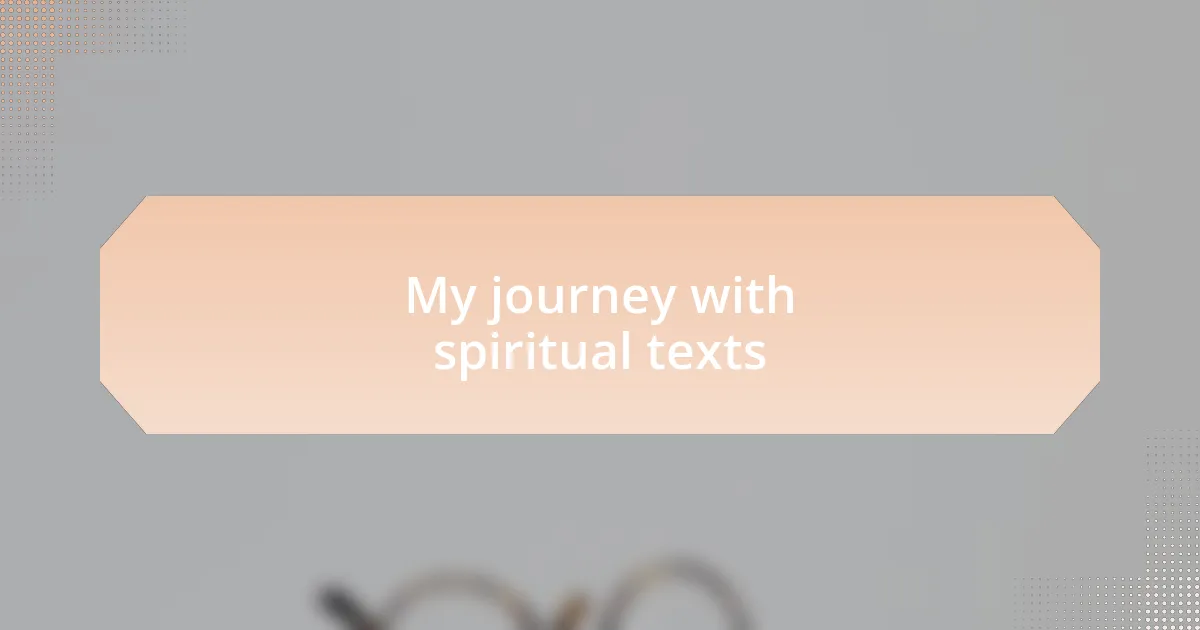
My journey with spiritual texts
My journey with spiritual texts began in my teenage years, sparked by a sense of confusion and longing for deeper meaning. I remember picking up a copy of “The Tao Te Ching,” and the simplicity of its wisdom struck me. The verses encouraged me to slow down and reflect on my life, reshaping how I approached everyday challenges. Have you ever encountered a text that seemed to speak directly to your soul? That was my first encounter.
As I matured, my exploration led me to diverse traditions, each offering unique insights. I was particularly moved by a book on Sufi poetry, which opened my eyes to the power of love and the divine connection. The lyrical beauty of the verses felt like a gentle embrace during times of heartache. How is it that poetry can encapsulate such deep emotions and truths? I found myself lost in those stanzas, and they guided me through my personal growth.
In recent years, I’ve gravitated towards texts that challenge my understanding of spirituality. A friend gifted me “The Power of Now,” and it was an eye-opener. The concepts of presence and awareness seemed daunting at first, pushing me out of my comfort zone. Yet, grappling with those ideas has led to profound shifts in how I perceive my daily life. What if embracing discomfort is a vital part of the spiritual journey? This question continues to drive my exploration of spiritual literature, shaping my path in unexpected ways.
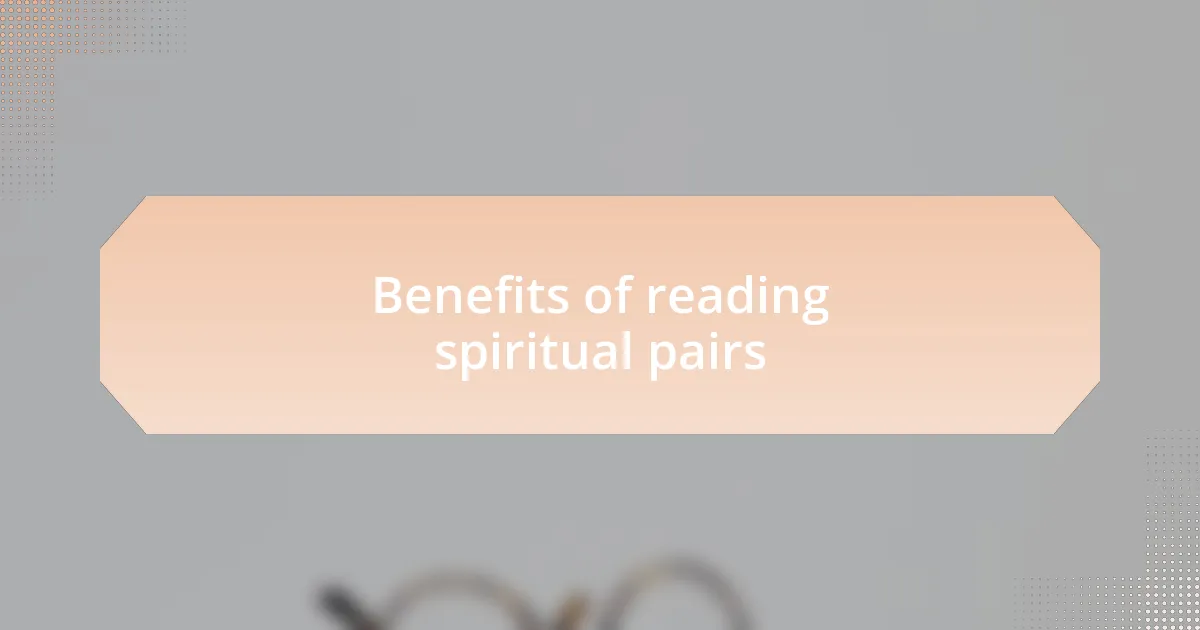
Benefits of reading spiritual pairs
Reading spiritual pair texts has enriched my understanding of complex ideas. For example, when I paired “The Dhammapada” with the teachings of Meister Eckhart, I discovered overlapping themes of mindfulness and detachment. This unexpected synergy prompted me to reflect deeply on how both philosophies emphasize living in the present, leading me to a more grounded state of being. Have you ever felt swept away by the wisdom of two different traditions converging?
Another benefit of exploring spiritual pairs is the way they encourage introspection. I recall reading Rumi alongside teachings from Thich Nhat Hanh. The contrast between Rumi’s passionate verses and Thich Nhat Hanh’s serene mindfulness teachings sparked questions about my own emotional responses. It felt like a gentle push to explore how my heart and mind interact during moments of joy or sorrow. Isn’t it fascinating how different perspectives can illuminate the same human experience?
Moreover, engaging with spiritual pairs often challenges me to break free from rigid beliefs. I had an enlightening experience reading “The Bhagavad Gita” along with “A Course in Miracles.” The tension between duty and love left me pondering my own life choices. This pairing led me to reassess my priorities and motivations in a deeply personal way. Can a shift in perspective really lead to profound change? In my case, it absolutely did, opening new paths for self-discovery on my spiritual journey.

Key lessons from my experiences
One key lesson I’ve learned from my experiences with spiritual texts is the importance of vulnerability. While reading “The Tao Te Ching” alongside “The Power of Now,” I encountered concepts that challenged my need for control. This clash prompted me to embrace uncertainty, allowing me to open up in ways I never thought possible. Have you ever felt that surrendering control could lead to greater freedom?
Another invaluable insight is the power of compassion. Pairing “The Bible” with the writings of the Dalai Lama highlighted the shared essence of love and kindness across different traditions. As I reflected on this, I felt called to practice compassion more actively in my daily life. It made me wonder: what transformations might occur if we all extended empathy consistently to ourselves and others?
Lastly, I discovered that grappling with contrasting beliefs can be a catalyst for growth. When I explored “The Upanishads” next to “The Alchemist,” the dialogues on destiny versus free will stirred an internal conversation. I realized that navigating my life’s path isn’t a straight line but rather a rich tapestry of choices and circumstances. How might your own journey change if you embraced the uncertainties of your path?